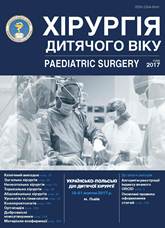Some aspects of diagnostics and treatment of pediatric patients with hydronophrosis
DOI:
https://doi.org/10.15574/PS.2017.56.89Keywords:
children, hydronephrosis, diagnosis, treatmentAbstract
Hydronephrosis is a progressive expansion of the pyelocaliceal system of kidney due to the urine outflow violation with the subsequent development of parenchymal atrophy.Objective: to substantiate the peculiarities of surgical intervention and drainage on the basis of the analysis of causes of the urodynamic disturbances in the pyeloureteral segment.
Material and methods. In the clinic over the past three years, 153 children with severe hydronephrosis have been treated. The overwhelming majority were boys (99), more often left-sided hydronephrosis (up to 93 cases) occured. When analyzing the age characteristics, up to 3 years 79 children (51.6%) were treated, but a significant number of patients were also older children. The overwhelming majority of patients underwent Hynes-Anderson pyeloplasty.
Results and discussion. The question of the need for drainage was decided individually, depending upon the child’s age, the cause of obstruction and the peculiarities of congenital abnormalities in the anatomical structure of the pyelocaliceal system and ureter. Most often used pyeloureterostomy, stenting of the urinary tract. Nephrostomy was performed in connection with the renal pediculitis. Complications were observed in 5 children, which amounted up to 3.2%.
Conclusions. With the enlarged renal pelvis, which measures more than 30%, the coin-like deformity of the calyces was indicative for the operative intervention.
With congenital hydronephrosis in young children, the optimal age is 4–6 months. With hydronephrosis transformation of kidney, even with a reduced function, surgical treatment is necessary.
References
Vozianov OF, Seymovsky DA, Bichar VE. (2000). Congenital malformations of the urinary tract in children. Ternopil, ukrmedk-book: 51-99.
Glybchenko PV, Alyaev YuG. (2011). Hydronephrosis: 202.
Lopatkin NA, Lyulko AV. (1987). Anomalies of the urinary system. Health: 414
Menovshchikova LB, Rudin YU, Garmanova TN. (2015). Clinical recommendations for pediatric urologist-andrology: 8-24.
Mudraya IS, Kirpatovsky VI, Maritov AG. (1993). Effect of urethral stent. Byul Expert Biol. 2: 144-147.
Rudin YE. (2000). Tactics of treatment of hydronephrosis in young children. Children's surgery. 3: 14-16.
Difficult diagnosis in urology. Per from english. (1997). Ed. D Mac-Callaha: 19-22.
Dhillon HK. (1998). Prenatally diagnosed hydroneposis: the Great Ormond Street experience. Br J Urol. 81(2): 39-41. https://doi.org/10.1046/j.1464-410X.1998.0810s2039.x; PMid:9602794
Framo G, De Dominicis C, Dal Forno S. (1990). The Icidence of Post-oper. Urin Tranct Inf. In Patients with Ur. Stent. Br. J. Urol. 65(1): 12-14.
Koff SA, Campbell KD. (1994). The nonoperative management of unilateral neonatal hydronephrosis: natural history of poorly functioning kidneys. J Urol. 152 (2Pt2): 593-5. https://doi.org/10.1016/S0022-5347(17)32658-7
Downloads
Issue
Section
License
The policy of the Journal “PAEDIATRIC SURGERY. UKRAINE” is compatible with the vast majority of funders' of open access and self-archiving policies. The journal provides immediate open access route being convinced that everyone – not only scientists - can benefit from research results, and publishes articles exclusively under open access distribution, with a Creative Commons Attribution-Noncommercial 4.0 international license(СС BY-NC).
Authors transfer the copyright to the Journal “PAEDIATRIC SURGERY.UKRAINE” when the manuscript is accepted for publication. Authors declare that this manuscript has not been published nor is under simultaneous consideration for publication elsewhere. After publication, the articles become freely available on-line to the public.
Readers have the right to use, distribute, and reproduce articles in any medium, provided the articles and the journal are properly cited.
The use of published materials for commercial purposes is strongly prohibited.

